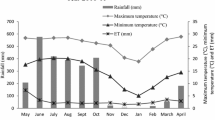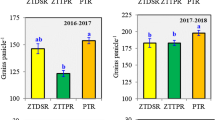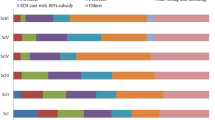Abstract
The crop and water productivity (WP) of monocropped rice in lowland of north-eastern region of India is low mainly due to cultivation of long duration variety, meagre use of fertilizer and manure, and inefficient water management, which needs to be improved for sustaining food security. Raised and sunken bed (RSB) land configuration (removing the surface soil layer from an area and depositing on the adjacent area to a height of about 50 cm by cutting and filling method) was demonstrated in a participatory research mode in farmers’ field during 2010–2012 for promoting crop diversification, enhancing crop and WP, and improving livelihood. The results indicated significant improvement in cropping intensity, productivity, employment, and income of farmers due to adoption of RSB land configuration compared to farmers’ practice (FP) of rice monocropping. The average rice equivalent yield (REY) of RSB land configuration was 16.20 t ha−1 compared to 3.24 t ha−1 under FP. The enhancement in employment and water-use efficiency were 445 and 291 % due to RSB over FP, respectively. The WP enhanced by four times due to RSB (0.69 kg m−3 water) compared to FP (0.18 kg m−3 water). In raised beds, the highest gross (USD 7,346 ha−1) and net returns (USD 4,524 ha−1) were recorded under tomato–okra–broccoli sequence, while in sunken beds, the highest gross and net returns were obtained under rice–pea (USD 2,633 and 1,590 ha−1, respectively) and these were substantially higher than those observed under FP (USD 775 ha−1 and USD 383 ha−1, respectively). Multiple cropping index, cultivated land utilization index, and diversity index also increased substantially due to RSB land configuration.



Similar content being viewed by others
References
Ali M, Abedullah (2002) Economic and nutritional benefits from enhanced vegetable production and consumption in developing countries’. J Crop Prod 6(1/2):145–176
Alliaume F, Rossing WAH, Tittonell PA, Jorge G, Dogliotti S (2014) Reduced tillage and cover crops improve water capture and reduce erosion of fine textured soils in raised bed tomato systems. Agric Ecosyst Environ 183:127–137
Anderson RI (2005) Are some crops synergistic to following crops? Agron J 97(1):7–10
Balasubramanian P, Palaniappan SP (2007) Principles of agronomy. Agrobios India, Jodhpur, pp 268–270
Bray RH, Kurtz LT (1945) Determination of total, organic and available forms of phosphorus in soils. Soil Sci 59:39–45
Bruijnzeel LA (2004) Hydrological functions of tropical forests: not seeing the soil for the trees? Agric Ecosyst Environ 104(1):185–228
Calder IR (2000) Land use impacts on water resources. Background paper 1. In: FAO Electronic Workshop on Land-Water Linkages in Rural Watersheds, 18 September–27 October 2000. http://www.fao.org/ag/agl/watershed/
Chris BG, Willem VV, Holly RB, Jeffrey JM (2010) Estimating the deep seepage component of the hillslope and catchment water balance within a measurement uncertainty framework. Hydrol Process. doi:10.1002/hyp.7788
Chuang FT (1973) An analysis of change of Taiwan’s cultivated land utilization for recent years. Rural Econ. Div., JCRR Rep. 21, Taipei, Taiwan
Dalrymple DF (1971) Survey of multiple cropping in less developed nations. United States Department of Agriculture, Washington D.C. FEDS, p 108
Das A, Patel DP, Munda GC, Hazarika UK, Bordoloi JS (2008) Nutrient recycling potential in rice – vegetable cropping sequences under in situ residue management at mid-altitude subtropical Meghalaya. Nutr Cycl Agroecosyst 82(3):251–258
Das A, Patel DP, Munda GC, Ghosh PK, Saha R, Bordoloi JS, Kumar M (2010) Productivity and soil nutrient balance sheet as influences by in situ biomass recycling in rice - vegetable cropping sequences. Environ Ecol 28(1):160–163
Das A, Patel DP, Ramkrushna GI, Munda GC, Ngachan SV, Kumar M, Bordoloi JS, Naropongla (2013a) Crop diversification and energy productivity under raised and sunken beds; results from a seven year study in a high rainfall organic production system. Biol Agric Hort. doi:10.1080/01448765.2013.854709
Das A, Patel DP, Munda GC, Ramkrushna GI, Manoj K, Ngachan SV (2013b) Improving productivity, water and energy use efficiency in lowland rice (Oryza sativa) through appropriate establishment methods and nutrient management practices in the mid-altitude of north-east India. Exp Agric. doi:10.1017/S0014479713000483
Datta KK, de Jong C (2002) adverse effect of waterlogging and soil salinity on crop and land productivity in northwest region of Haryana, India. Agric Water Manag 57(3):223–238
De Wit CT (1960) On competition. Verslag Land bouwkundige Onderzoekingen. Wageningen 66:1–81
Ghosh PK, Saha R, Das A, Tripathi AK, Samuel MP, Lama TD, Mandal S, Ngachan SV (2009) Participatory rain water management in hill ecosystem—a success story. Technical bulletin no. 67.FPARP-Phase I. ICAR Research Complex for NEH Region, Umiam-793 103, Meghalaya, p 37
Gill MS, Ahlawat IPS (2006) Crop diversification - its role towards sustainability and profitability. Indian J Fertil 2(9):125–138
Hashim MAA, Siam N, Al-Dosari A, Asl-Gaadi KA, Patil VC, Tola EHM, Rangaswamy M, Samdani MS (2012) Determination of Water Requirement and Crop water productivity of Crops Grown in the Makkah Region of Saudi Arabia. Aust J Basic Appl Sci 6(9):196–206
Islam M, Nath LK, Patel DP, Das A, Munda GC, Samajdar T, Ngachan SV (2014) Productivity and socio-economic impact of system of rice intensification and integrated crop management over conventional methods of rice establishment in eastern Himalayas, India. Paddy Water Environ 12:193–202
Jackson ML (1973) Soil chemical analysis. Prentice Hall of India, New Delhi
Jat RA, Dungrani RA, Arvadia MK, Sahrawat KL (2012) Diversification of rice (Oryza sativa L.)-based cropping systems for higher productivity, resource-use efficiency and economic returns in south Gujarat, India. Arch Agron Soil Sci 58(4–6):561–572
Joshi PK, Gulati A, Birthal PS (2003) Agriculture Diversification in South Asia: patterns, determinants and policy. MSSD Discussion Paper No. 57, Feb’03
Kannan K, Singh R, Kundu DK (2003a) Raised and sunken bed system for crop diversification in high rainfall areas. Indian J Agric Sci 73(8):453–455
Kannan K, Singh R, Kundu DK, Reddy GP (2003b) Fitting Malabar spinach in rice based cropping systems by modifying microenvironment in canal command areas of eastern region. Environ Ecol 21:1–3
Kharub AS, Chouhan DS, Sharma RK, Chhokar RS, Tripathi SC (2003) Diversification of rice–wheat system for improving soil fertility and productivity. Indian J Agron 48(3):149–152
Kumar A, Tripathi HP, Yadav RA, Yadav SR (2008) Diversification of rice (Oryza sativa) - wheat (Triticum aestivum) cropping system for sustainable production in eastern Uttar Pradesh. Indian J Agron 53(1):18–21
Luo SM, Lin RJ (1991) High bed-low ditch system in the Pearl River Delta. South-China. Agric Ecosyst Environ 36:101–109
Maliwal GL, Das A, Ramanp VP, Bambhaniyn LB (1998) Water management through land configuration in Bhal region. J Agric Sci 68(12):762–764
Mishra VK, Saha R (2007) Effect of raised-sunken bed sequence on inter-plot water harvesting and productivity of rice (Oryza sativa) and French bean (Phaseolous vulgaris) in Meghalaya. Indian J Agric Sci 77(2):73–78
Mishra MM, Nanda SS, Mohanty M, Pradhan KC, Mishra SS (2007) Crop diversification under rice based cropping system in western Orissa. In: Extended summaries 3rd National Symposium on Integrated Farming Systems, October 26–28, 2007 organized by Farming System and Development Association (Project Directorate for Cropping System Research, Modipuram, Meerut) at Agricultural Research Station, Durgapura, Jaipur
Munda GC, Patel DP, Das A, Kumar R, Chandra A (2006) Production potential of rice (Oryza sativa) under in situ fertility management as influenced by variety and weeding. J Eco-friendly Agric 1(1):12–15
Munda GC, Das A, Patel DP (2009) Evaluation of transplanted and ratoon crop for double cropping of rice (Oryza sativa L.) under organic input management in mid altitude sub-tropical Meghalaya. Curr Sci 96(12):1620–1627
Patel DP, Das A, Munda GC, Ghosh PK, Bordoloi JS, Kumar M (2010) Evaluation of yield and physiological attributes of high yielding rice varieties under aerobic and flood irrigated management practices in mid-hills ecosystem. Agric Water Manag 97:1269–1276
Patil EN, Jowale S, Mahayan MS (1995) Production potential, economics and fertility status of soil as influenced by wheat-based cropping system. Indian J Agron 40(4):544–548
Saha R (2011) Prediction of water requirement of garden pea (Pisum sativum) under hilly agro-ecosystem of Meghalaya. Indian J Agric Sci 81(7):633–636
Saha R, Ghosh PK (2010) Effect of land configuration on water economy, crop yield and profitability under rice (Oryza sativa)-based cropping sequences in north-east India. Indian J Agric Sci 80(1):16–20
Sharma PK, Datta SKD (1994) Rainwater utilization efficiency in rain-fed lowland rice. Adv Agron 52:85–120
Sharma RP, Pathak SK, Haque M, Raman KR (2004) Diversification of traditional rice (Oryza sativa) - based cropping systems for sustainable production in south Bihar alluvial plains. Indian J Agron 49(4):218–222
Sharma AK, Thakur NP, Koushal S, Kachroo D (2007) Profitable andenergy efficient rice-based cropping system under subtropical irrigated conditions of Jammu. In: Extended summaries 3rd National Symposium on Integrated Farming Systems, October 26–28, 2007 organized by Farming System and Development Association (Project Directorate for Cropping System Research, Modipuram, Meerut) at Agricultural Research Station, Durgapura, Jaipur
Siddiq EA, Kundu DK (1993) Production strategies for rice based cropping systems in humid tropics. International crop science 1. Crop Science Society of America, WI 53711, USA, pp 152–162
Singh R, Kundu DK, Mohanty RK, Ghosh S (2004) Crop diversification in canal irrigation commands of high rainfall areas through land configuration. Page 105 in Abs. In: Proc. National Symposium on Recent Advances in Rice Based Farming Systems, held at CRRI, Cuttack, Orissa 753006, India
Singh R, Kundu DK, Mohanty RK, Ghosh S, Kumar A, Kannan K (2005) Raised and sunken bed technique for improving water productivity in lowlands. Water Technology Centre for Eastern Region, Bhubaneswar, India, Research Bulletin No. 28, pp 1–42
Singh RK, Panda RK, Satapathy KK, Ngachan SV (2011) Simulation of runoff and sediment yield from a hilly watershed in the eastern Himalaya, India using the WEPP model. J Hydrol 405(3–4):261–276
Strout AM (1975) Some definitional problems with multiple cropping diversification. Philipp Econ J 14:308–316
Subbiah BV, Asija GL (1956) A rapid procedure for the determination of available nitrogen in soils. Curr Sci 25:259–260
Taha M, Gulati JML (2001) Influence of irrigation on yield and moisture utilization of groundnut (Arachis hypogaea L.). Indian J Agron 46(3):523–527
Tomar SS, Tembe GP, Sharma SK, Tomar VS (1996) Studies on some land management practices for increasing agricultural production in Vertisols of Central India. Agric Water Manag 30(1):91–106
Velayudharn K, Homamed A, Arunachalam AA, Velayudham A (1994) Effect of in situ moisture conservation practice on yield of rainfed crops. Indian J Agron 39:160–161
Walkley A, Black JA (1934) Estimation of soil organic carbon by chromic acid titration method. Soil Sci 17:29–38
Wang YT, Yu YH (1975) Historical evaluation and future prospect for multiple crop diversification. Philipp Econ J 14:26–46
Acknowledgments
The author sincerely acknowledges the Ministry of Water Resources, Govt. of India for providing financial support under the scheme Farmers’ Participatory Action Research Programme (FPARP) Phase-II to undertake the study.
Author information
Authors and Affiliations
Corresponding author
Rights and permissions
About this article
Cite this article
Das, A., Layek, J., Ramkrushna, G.I. et al. Raised and sunken bed land configuration for crop diversification and crop and water productivity enhancement in rice paddies of the north eastern region of India. Paddy Water Environ 13, 571–580 (2015). https://doi.org/10.1007/s10333-014-0472-9
Received:
Revised:
Accepted:
Published:
Issue Date:
DOI: https://doi.org/10.1007/s10333-014-0472-9




